ICD-10: What You Need to Know
ICD-10 is a foundational component of modern healthcare systems, enabling accurate diagnosis coding, billing, and data analysis. Its specificity and comprehensive structure have revolutionized the way healthcare data is documented and used globally. Understanding the key features of ICD-10, its benefits, and its challenges is essential for healthcare professionals, coders, and insurers as they navigate the evolving landscape of healthcare. As the industry continues to advance, ICD-10 will remain a crucial tool in delivering efficient, high-quality care.

What is ICD-10?
ICD-10 is the 10th revision of the International Classification of Diseases, a medical classification system that provides detailed codes for diseases, conditions, and injuries. The ICD-10 system includes codes for:
- Diseases and disorders
- Injuries and poisoning
- Symptoms and abnormal findings
- External causes of injury
- Social circumstances affecting health
These codes help healthcare providers accurately document patient conditions and communicate with insurers to facilitate billing and reimbursement.
Structure of ICD-10 Codes
ICD-10 codes are alphanumeric and can be up to seven characters long, providing greater specificity than the previous version, ICD-9. Each part of the code provides information about the category of disease or condition, anatomical location, and severity. For example:
- A00: Cholera
- J45.901: Unspecified asthma with (acute) exacerbation
This level of detail allows healthcare providers to record precise diagnoses, improving data accuracy for patient care and health analytics.
Why was ICD-10 Introduced?
ICD-10 was introduced to address the limitations of its predecessor, ICD-9. The older system had fewer codes and was unable to capture many modern diseases and medical advancements. ICD-10 offers:
- Greater specificity: More detailed codes for diagnoses and procedures
- Improved data collection: Better tracking of public health trends, diseases, and treatments
- Enhanced clinical documentation: More accurate descriptions of patient conditions, leading to better care planning
By improving the accuracy of health data, ICD-10 supports more effective healthcare delivery and resource allocation.
How ICD-10 Differs from ICD-9
ICD-10 introduced several key changes from ICD-9, including:
- More codes: ICD-10 has over 68,000 codes compared to ICD-9’s 13,000, offering much greater specificity.
- Alphanumeric codes: ICD-10 codes use both letters and numbers, whereas ICD-9 codes were entirely numeric.
- Expanded code length: ICD-10 codes can be up to seven characters long, providing more detailed information about the diagnosis or procedure.
These changes allow for better documentation of conditions and treatment methods, making ICD-10 more adaptable to modern healthcare needs.
Benefits of ICD-10
The adoption of ICD-10 has brought several benefits to healthcare systems around the world:
- Better patient care: By providing more detailed codes, ICD-10 improves clinical documentation, which can lead to better patient outcomes.
- Accurate billing and reimbursement: ICD-10 helps healthcare providers and insurers process claims more efficiently and accurately, reducing billing errors and improving reimbursement rates.
- Improved public health data: ICD-10 supports the collection of more detailed health statistics, which are essential for tracking diseases, planning health services, and conducting medical research.
Who Uses ICD-10?
ICD-10 is used globally by:
- Hospitals and clinics: To document diagnoses and treatments for patients.
- Health insurers: For processing claims and determining reimbursement.
- Government health organizations: For collecting health statistics and monitoring public health trends.
- Researchers: To analyze health data and track the prevalence of diseases.
ICD-10-CM vs. ICD-10-PCS
In the United States, two versions of ICD-10 are used:
- ICD-10-CM (Clinical Modification): Used for coding diagnoses in all healthcare settings, including diseases, symptoms, and external causes of injury.
- ICD-10-PCS (Procedure Coding System): Used to code inpatient procedures performed in hospitals and is more detailed than ICD-10-CM.
Healthcare providers must be familiar with both coding systems to ensure accurate documentation and billing.
Challenges of Implementing ICD-10
The transition to ICD-10 posed several challenges for healthcare providers and organizations:
- Training: Healthcare providers, coders, and billing staff required extensive training to learn the new system and understand its structure.
- Cost: Implementing ICD-10 required significant investment in software updates, training, and hiring additional staff.
- Coding complexity: The increased number of codes and their complexity made coding more time-consuming and required greater attention to detail.
Despite these challenges, the long-term benefits of ICD-10, such as improved accuracy in healthcare data and billing, have outweighed the initial difficulties.
ICD-10 and Future Healthcare Trends
Looking ahead, ICD-10 is expected to play a critical role in the future of healthcare. As the industry moves toward value-based care and personalized medicine, the specificity of ICD-10 codes will help healthcare providers track patient outcomes more effectively. Furthermore, as healthcare becomes more digitized, ICD-10 will integrate more seamlessly with electronic health records (EHRs) and artificial intelligence (AI) tools, improving coding accuracy and efficiency.
10. The Move to ICD-11
While ICD-10 is currently the global standard, the World Health Organization (WHO) has already introduced ICD-11, the latest version of the classification system. ICD-11 offers even more detailed codes, better integration with digital health technologies, and improved compatibility with electronic health records. As countries gradually transition to ICD-11, healthcare providers will need to stay updated on coding changes and prepare for future transitions.

